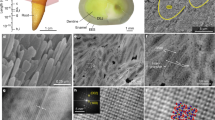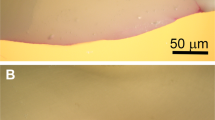Abstract
The dentin–enamel junction (DEJ), which is the interfacial region between the dentin and outer enamel coating in teeth, is known for its unique biomechanical properties that provide a crack-arrest barrier for flaws formed in the brittle enamel1. In this work, we re-examine how cracks propagate in the proximity of the DEJ, and specifically quantify, using interfacial fracture mechanics, the fracture toughness of the DEJ region. Careful observation of crack penetration through the interface and the new estimate of the DEJ toughness (∼5 to 10 times higher than enamel but ∼75% lower than dentin) shed new light on the mechanism of crack arrest. We conclude that the critical role of this region, in preventing cracks formed in enamel from traversing the interface and causing catastrophic tooth fractures, is not associated with the crack-arrest capabilities of the interface itself; rather, cracks tend to penetrate the (optical) DEJ and arrest when they enter the tougher mantle dentin adjacent to the interface due to the development of crack-tip shielding from uncracked-ligament bridging.
This is a preview of subscription content, access via your institution
Access options
Subscribe to this journal
Receive 12 print issues and online access
$259.00 per year
only $21.58 per issue
Buy this article
- Purchase on Springer Link
- Instant access to full article PDF
Prices may be subject to local taxes which are calculated during checkout




Similar content being viewed by others
References
Lin, C. P., Douglas, W. H. & Erlandsen, S. L. Scanning electron microscopy of Type I collagen at the dentin enamel junction of human teeth. J. Histochem. Cytochem. 41, 381–388 (1993).
White, S. N. et al. The dentino-enamel junction is a broad transitional zone uniting dissimilar bioceramic composites. J. Am. Ceram. Soc. 83, 238–240 (2000).
Ten Cate, A. R. Oral Histology: Development, Structure, and Function 4th edn (Mosby, St. Louis, Missouri, 1994).
Hassan, R., Caputo, A. A. & Bunshah, R. F. Fracture toughness of human enamel. J. Dent. Res. 40, 820–827 (1981).
Xu, H. H. et al. Indentation damage and mechanical properties of human enamel and dentin. J. Dent. Res. 77, 472–480 (1998).
Marshall, G. W., Marshall, S. J., Kinney, J. H. & Balooch, M. The dentin substrate: Structure and properties related to bonding. J. Dent. 25, 441–458 (1997).
Imbeni, V., Nalla, R. K., Bosi, C., Kinney, J. H. & Ritchie, R. O. On the in vitro fracture toughness of human dentin. J. Biomed. Mater. Res. A 66, 1–9 (2003).
Iwamoto, N. & Ruse, N. D. Fracture toughness of human dentin. J. Biomed. Mater. Res A 66, 507–512 (2003).
Tesch, W. et al. Graded microstructure and mechanical properties of human crown dentin. Calcified Tissue Int. 69, 147–157 (2001).
Habelitz, S., Balooch, M., Marshall, S. J., Balooch, G. & Marshall, G. W. In situ atomic force microscopy of partially demineralized human dentin collagen fibrils. J. Struct. Biol. 38, 227–236 (2002).
Marshall, G. W., Balooch, M., Gallagher, R. R., Gansky, S. A. & Marshall, S. J. Mechanical properties of the dentin-enamel junction: AFM studies of nanohardness, elastic modulus and fracture. J. Biomed. Mater. Res. 54, 87–95 (2001).
Habelitz, S., Marshall, S. J., Marshall, G. W. & Balooch, M. The functional width of the dentino-enamel junction determined by AFM-based nanoscratching. J. Struct. Biol. 135, 244–301 (2001).
Lin, C. P. & Douglas, W. H. Structure-property relations and crack resistance at the bovine dentin-enamel junction. J. Dent. Res. 73, 1072–1078 (1994).
Dong, X. D. & Ruse, N. D. Fatigue crack propagation path across the dentinoenamel junction complex in human teeth. J. Biomed. Mater. Res. A 66, 103–109 (2003).
Rasmussen, S. T. & Patchin, R. E. Fracture properties of human enamel and dentin in an aqueous environment. J. Dent. Res. 63, 1362–1368 (1984).
Rasmussen, S. T. Fracture properties of human teeth in proximity to the dentinoenamel junction. J. Dent. Res. 63, 1279–1283 (1984).
Lin, C. P. & Douglas, W. H. Fracture mechanics at the human dentin-resin interface: a fracture mechanics approach. J. Biomech. 27, 1037–1047 (1994).
Urabe, I., Nakajima, M., Sano, H. & Tagami, J. Physical properties of the dentin-enamel junction region. Am. J. Dent. 13, 129–135 (2000).
Wang, R. Z. & Weiner, S. Strain-structure relations in human teeth using Moire fringes. J. Biomech. 31, 135–141 (1998).
Fong, H., Sarikaya, M., White, S. N. & Snead, M. L. Nano-mechanical properties profiles across dentin-enamel junction of human incisor teeth. Mater. Sci. Eng. C 7, 119–128 (2000).
Sun, E. Y. et al. Debonding behavior between β-Si3N4 whiskers and oxynitride glasses with or without β-SiAlON interfacial layer. Acta Mater. 47, 2777–2785 (1999).
He, M. -Y. & Hutchinson, J. W. Crack deflection at an interface between dissimilar elastic materials. Int. J. Solids Struct. 25, 1053–1067 (1989).
Shang, J. K. & Ritchie, R. O. Crack bridging by uncracked ligaments during fatigue-crack growth in SiC-reinforced aluminum-alloy composites. Metall. Trans. A 20, 897–908 (1989).
Kruzic, J. J., Nalla, R. K., Kinney, J. H. & Ritchie, R. O. Crack blunting, crack bridging and resistance-curve fracture mechanics of dentin: Effect of hydration. Biomater. 24, 5209–5221 (2003).
Nalla, R. K., Kruzic, J. J., Kinney, J. H. & Ritchie, R. O. Mechanistic aspects of fracture and R-curve behavior in human cortical bone. Biomater. 26, 217–231 (2005).
Yeni, Y. N. & Fyhrie, D. P. A rate-dependent microcrack-bridging model that can explain the strain rate dependency of cortical bone apparent yield strength. J. Biomech. 36, 1343–1353 (2003).
Habelitz, S., Marshall, G. W., Balloch, M. & Marshall, S. J. Nanoindentation and storage of teeth. J. Biomechanics 35, 995–998 (2002).
Lawn, B. R. Fracture of Brittle Solids 2nd edn (Cambridge Univ. Press, Cambridge, 1993).
Dundurs, J. Edge-bonded dissimilar orthogonal elastic wedges. J. Appl. Mech. 36, 650–652 (1969).
Ritchie, R. O. Mechanisms of fatigue crack propagation in metals, ceramics and composites: Role of crack-tip shielding. Mater. Sci. Eng. 103, 15–28 (1988).
Acknowledgements
This work was supported in part by the National Institutes of Health, National Institute of Dental and Craniofacial Research, under Grant No. R01 DE 13029 (for V.I., G.W.M., S.J.M.), and by the Director, Office of Science, Office of Basic Energy Science, Division of Materials Sciences and Engineering of the Department of Energy under Contract No. DE-Ac03-76SF00098 (for J.J.K., R.O.R.). The authors wish to thank Grace Nonomura for specimen preparation, and Cynthia Chao, Kevin Liu, Earnst Young, Ravi Nalla and Eduardo Saiz for experimental assistance.
Author information
Authors and Affiliations
Corresponding author
Ethics declarations
Competing interests
The authors declare no competing financial interests.
Rights and permissions
About this article
Cite this article
Imbeni, V., Kruzic, J., Marshall, G. et al. The dentin–enamel junction and the fracture of human teeth. Nature Mater 4, 229–232 (2005). https://doi.org/10.1038/nmat1323
Received:
Accepted:
Published:
Issue Date:
DOI: https://doi.org/10.1038/nmat1323
This article is cited by
-
Fractional Modeling in Action: a Survey of Nonlocal Models for Subsurface Transport, Turbulent Flows, and Anomalous Materials
Journal of Peridynamics and Nonlocal Modeling (2023)
-
Accelerating Optimization Design of Bio-inspired Interlocking Structures with Machine Learning
Acta Mechanica Solida Sinica (2023)
-
Detection of cracked teeth using a mechanoluminescence phosphor with a stretchable photodetector array
NPG Asia Materials (2022)
-
Mechanically robust supramolecular polymer co-assemblies
Nature Communications (2022)
-
Printable, castable, nanocrystalline cellulose-epoxy composites exhibiting hierarchical nacre-like toughening
Cellulose (2022)



